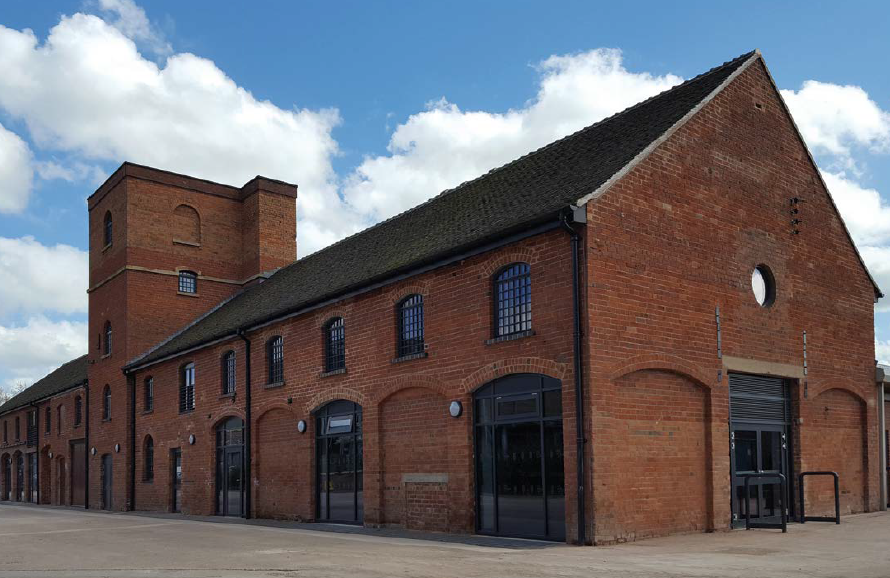AgriSTEM

|
| The AgriSTEM Academy, involved the conversion of a derelict old granary building with a water tower, at the heart of South Staffordshire College’s Rodbaston Campus. This landmark building, whilst not listed, has significant architectural merit and the sensitive approach to renovation sought to respect its historic stature and retain the original character. |
As the granary previously housed pigs and sheep, we took a conscious design decision to incorporate agricultural materials into the architecture. We selected hard-wearing materials such as polished concrete. This provided a smooth level floor that allows equipment on wheels to be relocated with ease and is hard enough to cope with the outdoor work boots of students learning in an agricultural environment. We selected sustainably-sourced oak for doors, frames, architrave and skirting. As these are not primed and painted they do not chip, become scuffed or show signs of ageing or require redecorating. With a little initial investment at the beginning, the life cycle costs benefit the college budget over time. The internal materials and colour palette were linked to those used externally, e.g. the Corten cladding used to the external fire escape staircase is reflected in the IPS/toilet cubicle laminate. We provided a visual reference to the building’s original use, through ‘head of grain’ manifestations on glazed screens and windows.
The granary, having stood empty for many years, was not structurally safe for educational requirements. A steel frame had to be needled into the existing fabric - that meant removing the entire roof. Retaining the queen post roof trusses, and adding the steel in parallel, avoided the steel dominating the exposed ceiling and preserved the building’s original look and feel. We initially thought a number of recessed brick arches on the ground and first floors could be opened up to add windows for natural light within the space. These were in fact dummy openings and not structural, so we had to work with the structural engineer to design bespoke curved supports. We rationalised the openings and windows to get additional light without adding pressure to the project costs.

|
To accommodate the high number of bats observed in the area, we worked with the ecologist adding brick-faced roosts and a bat loft. We avoided using a breathable membrane, as bats can get their claws trapped in the fibres, instead we used traditional roofing felt.
We supported the College drive for sustainability and renewable energy in the design where possible. An energy dashboard was incorporated to display the development’s energy use to benchmark against good practice. The granary was thermally-upgraded using a consistent insulated fabric that sealed the roof and walls. Foiled tape joints allow for a low target air leakage rate. Window and door reveals had design consideration whilst maintaining conservation style window frames. We wanted to maintain the thin lines and proportions of the existing single glazed metal windows. After researching and obtaining samples, we found a manufacturer that produced a super thin-line profile that gave us the thermal performance and conservation style window we wanted. The existing floor was removed to install the new steel foundations providing an ideal opportunity to insulate and add waterproofing to omit any damp in the existing building.
Meeting the necessary acoustic standards was a challenge. Existing ground floor ceiling clearance was restricted, requiring careful design coordination of acoustic rafts above mechanical ductwork and equipment. We obtained the necessary requirements, whilst exposed components became a feature that could be serviced, maintained and replaced without disturbing the acoustic panels in the future. At first floor we wanted to retain the original sloped soffit - exposed as a feature. Therefore, the acoustic treatment needed to be thoughtfully integrated within the ceiling system. With large areas of glazing and exposed brickwork we made a conscious decision not to use acoustic wall panels and baffles that would obscure the original fabric and historic design. By using an innovative perforated timber panelling that lined the entire underside of the sloped roof, we achieved the acoustic performance.
The client’s brief was to design and deliver an outstanding award-winning building they could be proud of. The state-of-the-art facility houses specialist equipment like the mechatronics production line that replicates equipment and systems found in industry, such as Jaguar, Land Rover and local food manufacturers. This high-end equipment contrasts with the traditional aspect of the building fabric and the pair complement each other. Seeing swallows return the following spring to nest in the exposed eaves is satisfying, knowing the building has been transformed sensitively, respecting its environment and the College can proudly promote their specialist courses and unique facility.
The project was commended in CIAT's Architectural Technology Awards 2018, Award for excellence in architectural technology.
|
Judge’s comments: The transformation of this derelict building, together with the extensive ecological research carried out, brought together complimentary disciplines in this innovative project. Simple, but effective detailing together with a well-considered internal layout and a well-insulated fabric has produced a finished project which would compare well with a building construction to today’s standards. A key factor in the project was following the client’s brief to create a building the college is proud of. |
This article originally appeared in CIAT’s Architectural Technology Journal, published in Autumn 2018. It was written by Maber Architects.
--CIAT
[edit] Related articles on Designing Buildings Wiki
- CIAT.
- Alterations and extension to The Grange.
- Architectural Technology Awards 2017.
- Architectural Technology Awards 2018.
- Architectural technologist - delineation of roles.
- Architectural technician.
- Architectural technologist.
- Gresham's School Britten Building.
- Old Gale Farm, Ambleside.
- The Engine Shed.
IHBC NewsBlog
Images from inside a Grade II listed hotel show the scale of its collapse
The Corbett Arms in Tywyn has fallen into serious disrepair.
Old Sarum fire in listed (& disputed) WW1 Hangar - Wiltshire Council has sought legal advice after fire engulfed a listed First World War hangar that was embroiled in a lengthy planning dispute.
UK Antarctic Heritage Trust launches ‘Virtual Visit’ website area
The Trust calls on people to 'Immerse yourself in our heritage – Making Antarctica Accessible'
Southend Council pledge to force Kursaal owners to maintain building
The Council has pledged to use ‘every tool in the toolbox’ if urgent repairs are not carried out.
HE’s Research Magazine publishes a major study of the heritage of England’s suburbs
The article traces the long evolution of an internal programme to research 200 years of suburban growth
IHBC Context 183 Wellbeing and Heritage published
The issue explores issues at the intersection of heritage and wellbeing.
SAVE celebrates 50 years of campaigning 1975-2025
SAVE Britain’s Heritage has announced events across the country to celebrate bringing new life to remarkable buildings.
IHBC Annual School 2025 - Shrewsbury 12-14 June
Themed Heritage in Context – Value: Plan: Change, join in-person or online.
200th Anniversary Celebration of the Modern Railway Planned
The Stockton & Darlington Railway opened on September 27, 1825.
Competence Framework Launched for Sustainability in the Built Environment
The Construction Industry Council (CIC) and the Edge have jointly published the framework.














